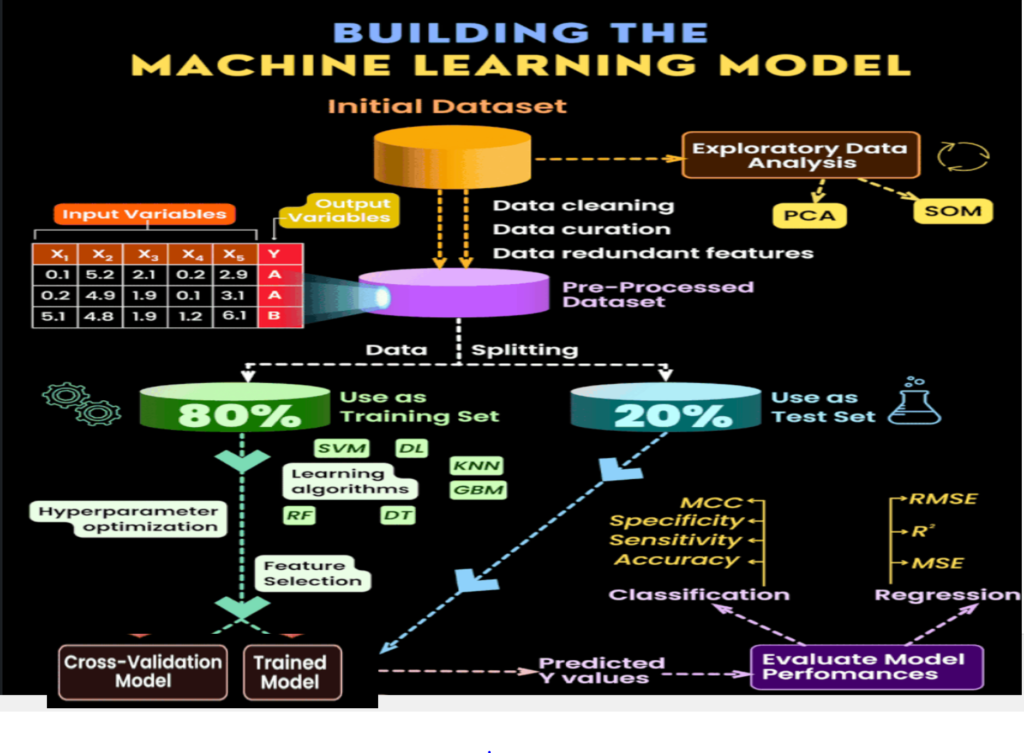𝗕𝘂𝗶𝗹𝗱𝗶𝗻𝗴 𝘁𝗵𝗲 𝗠𝗮𝗰𝗵𝗶𝗻𝗲 𝗟𝗲𝗮𝗿𝗻𝗶𝗻𝗴 𝗠𝗼𝗱𝗲𝗹 :
𝗞𝗲𝘆 𝗦𝘁𝗲𝗽𝘀 𝗶𝗻 𝗕𝘂𝗶𝗹𝗱𝗶𝗻𝗴 𝗮 𝗠𝗼𝗱𝗲𝗹:
↳ Data Collection: Gather and aggregate data relevant to the problem you want to solve.
↳ Data Cleaning: Handle missing values, remove duplicates, and correct inconsistencies.
↳ Feature Engineering: Transform raw data into meaningful features that improve model accuracy.
↳ Data Splitting: Divide the dataset into training, validation, and test sets to ensure unbiased evaluation.
𝗧𝗿𝗮𝗶𝗻𝗶𝗻𝗴 𝘁𝗵𝗲 𝗠𝗼𝗱𝗲𝗹:
↳ Select the Algorithm: Choose an appropriate machine learning algorithm based on the problem type (e.g., classification, regression).
↳ Model Training: Feed the algorithm with the training data to find patterns and learn from them.
↳ Hyperparameter Tuning: Adjust the model parameters to optimize performance and prevent overfitting.
𝗠𝗼𝗱𝗲𝗹 𝗘𝘃𝗮𝗹𝘂𝗮𝘁𝗶𝗼𝗻:
↳ Cross-Validation: Use techniques like k-fold cross-validation to validate model performance.
↳ Metrics Analysis: Evaluate the model using metrics like accuracy, precision, recall, and F1-score.
↳ Model Refinement: Based on evaluation, refine and adjust the model to enhance accuracy.
𝗢𝗽𝘁𝗶𝗺𝗶𝘇𝗶𝗻𝗴 𝘁𝗵𝗲 𝗠𝗼𝗱𝗲𝗹:
↳ Regularization Techniques: Apply techniques like L1 or L2 regularization to prevent overfitting.
↳ Algorithm Selection: Consider using ensemble techniques like Random Forest or Gradient Boosting for better accuracy.
𝗥𝗲𝗮𝗹-𝗪𝗼𝗿𝗹𝗱 𝗔𝗽𝗽𝗹𝗶𝗰𝗮𝘁𝗶𝗼𝗻𝘀:
↳ Predictive Analytics: Build models to forecast trends and customer behaviors.
↳ Natural Language Processing (NLP): Use machine learning to analyze text and sentiment.
↳ Computer Vision: Implement models to identify objects and patterns in images.
𝗖𝗵𝗮𝗹𝗹𝗲𝗻𝗴𝗲𝘀 𝗙𝗮𝗰𝗲𝗱 𝗶𝗻 𝗠𝗼𝗱𝗲𝗹 𝗕𝘂𝗶𝗹𝗱𝗶𝗻𝗴:
↳ Data Quality: Poor data quality can lead to inaccurate predictions.
↳ Bias & Variance Trade-off: Balancing bias and variance is crucial to avoid overfitting or underfitting.
↳ Model Interpretability: Complex models like neural networks can be challenging to interpret.
𝗛𝗼𝘄 𝗶𝘁 𝗪𝗼𝗿𝗸𝘀:
1. Data Preparation: Ensure data is clean, relevant, and well-structured for the model.
2. Algorithm Training: The model learns patterns from the training dataset to make predictions.
3. Evaluation and Testing: Test the model against unseen data to validate its performance.


